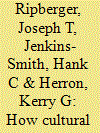| Srl | Item |
| 1 |
ID:
110650


|
|
|
|
|
| Publication |
2011.
|
| Summary/Abstract |
Scholars have used cultural theory (CT) to explain risk perceptions and opinion formation across an impressive array of public issues, ranging from environmental, regulatory, and energy policy to public health and economics. Although disparate, all these issues concern domestic policies. This article breaks with this trend by exploring the extent to which CT can help scholars better understand public beliefs about national security. Of critical importance in debates about national security are perceptions of individual versus collective threat and the appropriate role of authoritative institutions in protecting society from these threats. Because CT provides a framework that explicitly addresses these dimensions, national security issues provide an illuminating canvas for evaluating the theory's explanatory utility.
|
|
|
|
|
|
|
|
|
|
|
|
|
|
|
|
| 2 |
ID:
123766


|
|
|
|
|
| Publication |
2013.
|
| Summary/Abstract |
The creation of a national identity shared by the whole population becomes increasingly difficult in individualizing and globalizing national societies. The national population fragments into many lifestyle groups with very different social and cultural orientations. The enactment of these different lifestyle identities during leisure activities accentuates these differences. However, these different identities are sometimes performed on the same spatial stage. The main part of this article analyses the use of the dike along the river Linge, a part the Rhine estuary, which, lined with apple trees, cuts through an iconic Dutch river landscape with polders, old villages and meadows with quietly grazing cattle. Especially during the weekends, it is a stage crowded by walkers, cyclists, classic car drivers, and motorcyclists. The importance attached to this river dike is linked to a shared traditional form of Dutch collective national identity. The different uses of the river dike are based to the diverging values on which the different lifestyles are based. This results in conflicts over the use of and access to the dike. The role of the state in regulating these conflicts results in a more limited form of national identity.
|
|
|
|
|
|
|
|
|
|
|
|
|
|
|
|